
Fencing History
Brief history of a technique, of a science, an art, a sport and (or) a method of education
Whether we consider fencing as an art of enjoyment or as a science of arms, a method of education or a sport, its wealth emerges from its study. Wealth of a thousand-year-old history, of a large technical skill and a laudatory record of achievements, wealth of champions and masters who force the respect, and above all wealth of values that fencing knew how to generate and that it still tries to inculcate today through its practice. The history of this sport is very eloquent, it often relates that of humankind through that of the sword and, if we analyse the feature of the art of weapons, we immediately notice that it corresponds to the customs of the era in which it appears. The human being has always tried to invent weapons to defend himself against the nature and other human beings, and this si nce Caïn: he used his strength, resorted to his material, improved his dexterity and used his intelligence. The history of fencing gives a marvellous account of all that.
The Pharaohs invent the mask and the competition
Four centuries before the Olympic Games of Antique Greece, a bas-relief in the temple of Medinet-About in High Egypt and built by Ramsès III in 1190 BC, depicts a sporting competition organised by the Pharaoh to celebrate his victory over the Libyans. The weapons - certainly sticks with bronze plates in the end - are buttoned. Hands are protected by a guard similar to that of sabre, and some of the fencers have the face protected by a mask, whose chin rolling pad, covering both ears, is attached to the wig. The non-sword arm is used for parrying blows and is protected by a kind of shield. The translation of hieroglyphs teaches us that the opponents shouted at each other « On guard … and admire what my valiant hand is going to make! », and that spectators did not spare encouragements for their favourites: « Go ! O excellent fighter! ». The winner salutes with his weapon and hand the Pharaoh who is accompanied by his suite. The public is composed of Assyrians, Libyans and Egyptians; the jury and the organisers are recognizable thanks to their feather. A scribe notes on a papyrus the results of the competition.
The Games of the Olympe
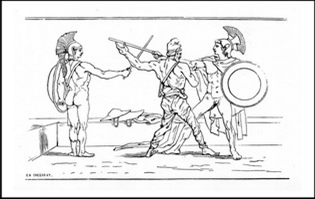
It is necessary to cross ages and transport ourselves in Greece to find in the hoplomachie (fight with weapons one to one) the tracks of a competition where prizes were proposed to the winners, « grown men or children ». Many of us know that fencing was included in the programme of the first games of the new era, in 1896, but many ignore that it was certainly included in the first Olympic Games in 776 BC.
Sensitive to the equal education of the body and the soul of their youth, the Greeks honoured all the games preparing to the profession of arms. Olympic combats in which athletes (word derived from the Greek « combat ») had to be Greek, free and beyond reproach. If the first laurels awarded during these events are regrettably unknown to us, we can learn from the Dictionary of Greek and Roman Antiques, 3 that in the IIIrd century, in Teos, in Greece, the «hoplomachès» (fencing master) was paid 300 drachmas: much more than the archery master or javelin master. This book evokes, in the 5th century, two masters with a great reputation (Euthydème and Dyonysodore) who taught the hoplomachie (fencing) in return for a great reward
Thrusting fencing of the Romans
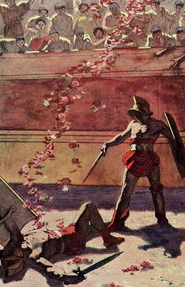
In the XII th and XIIIth centuries, we already meet in France « givers of lessons » and advice in fencing, whose function was to prepare to the judicial duel and, sometimes, against very high sum, replace on the spot the parties in presence. There were the counsels of arms, who became the « bravi » of Lombardie and the swordplayer and maistres.The judicial duels took place until the XVI th century. The truth and the right cause could only triumph in these « God judgements » in which sword ruled and divided the truth from the false ;the faith, for which the glory was only vanity, could only praise the value through the filter of a highly moral purpose. Further some miscarriages of justice in which «God’s hand» had less weight than the power of fencing, the ordeal (from the old English ordal and German urthel) was finally suppressed and replaced by a more human justice. The fact remains that the symbols of sword and justice crossed the centuries and are still today associated, imbuing fencing with a strong ethics.
Rebirth of fencing, a talent of court

Thrusting fencing, which according to Vegèce allowed the successes of the Roman soldiers, is almost non-existent in the Middle Ages, because the only law is then that of the strongest, in combats where the mace, the battle- axe, the halberd or the two-handed sword could not match with the subtlety of thrusting fencing.Nevertheless, this technique returns in the XVI th century.
Armors disappear, because the « thunder of the earth », the gunpowder, made them obsolete.For that reason the weapons are modified, swords slowly become a wardrobe accessory : they are not necessarily shorter, but their centre of gravity is returned towards the hand, they are henceforth lighter and held by a single hand. The Italian and Spanish methods spread through France, advocating the superiority of the hit with the point and clarifying the various techniques of attack and defence. The counsels of arms, the swordplayer and maistres taught first the defensive, which consisted in keeping the opponent at distance (the « misura » or measure), avoiding strikes or « parrying » the opponent-attack. The second concern was the search of « time », the convenient moment to attack, in measure, and out of the opponent’s time. Because of the lightering of weapons and their grip in one hand, one arm will be affected to the defensive. In the beginning, this arm was armed with a shield or a broquel, with the brachium or with the rondache, then with a dagger, or even with a rolled coat. The perfection of weapons at the level of the guard will then allow to bring together in a single weapon, the offensive and the defensive; some people see there the real birth of fencing. So, we shall see complicated, tormented guard, in which the opposite blade had to get lost, jam or break itself. Finally, appears the rapier, or brette (long sword), with deep coquille, allowing a good sheltering of the hand. Its use, combined with the dagger, will increase the defensive and offensive potential, while making the attack safer.
French fencing, conventional foil

Before the middle of the XVII th century, there are only few French among the famous fencing masters ; Noël Carré, Jacques Ferron, le Flamand, Petit-Jean and, of course, Sainct-Didier, are the sole famous maistres en faict fencing masters, who taughtthe noble science of arms to the most quarrelsome court of the world. Henry de Sainct-Didier was not only the first French author (1573), the first one to speak about «floures » or foil, but also the real first teacher.He will be imitated only 60 years later, in 1635, by Le Perche du Coudray : those who are skilful in both the handling of the blade and the pen are rare, even if fencing and writing are more and more alike.Molière will not make anything to bring closer these « sciences » and their masters;
but his Bourgeois Gentilhomme (Gentleman) will however remain a remarkable document on more than one point. He will summarize quite exactly fencing as the « art of hitting without being hit ». So during the combat, all the art consisted in first not being hit and hit if possible. It is really under Louis XIV (to whom we owe the shortening of the court sword) that the French method begins to distinguish itself, especially with the adoption of short foil, ended by an esteuf or button. Thrusting fencing improves, the moves become faster and more complicated and are only slowed down by the absence of the mask, which holds back the ardour of the fencers. To avoid accidents, each fencer gave a simple strike, that the opponent tried to parry without riposting; the attacker stood up and expected the riposte (at lost time) from his opponent. No remise nor stop which could have misled the point.
Progress and development of fencing

The classification of actions, the definition of terms and the teaching methods were progressively established by French masters, who left remarkable writings : Le Perche du Coudray (fencing master of Cyrano) in 1635 and 1676, Besnard in 1653 (master of Descartes), la Touche in 1670, Labat from Toulouse in 1690. The fencing phrase was actually created with the appearance of the mask with metal mesh (replacing those made of white iron with openings),
about which Girard speaks already in 1736, and which allowed the remises, the stop hits, the redoublings and counter-ripostes. La Boëssière (father) demonstrated its importance and imposed it.The masters Danet (1766) and La Boëssière (1766) brought their style to the elaboration of a French method which is both revolutionary and conventional. Conventional because its practice was more and more codified and regulated. Revolutionary because of its technique but above all because the Revol ution had changed the mentalities. The nobility, or what remained from it, was not anymore the only one interested in 11 handling the sword and being able to do it ; the middle-class, the writers frequented more and more the fencing school and the « pré aux clercs ». Freedom was progressing on each side of the grip. Modern fencing was really born at the beginning of the XIX th century and was consecrated by the romanticism thanks to masters such as Lafaugère (1815), Gomard (1845), Grisier (1867), Cordelois (1872), or Bertrand, incomparable fencer and outstanding demonstrator, who modified the guard, improved the riposte, established the rules for the time, stop hits, remises and redoublings.
Fencing, an art of sport
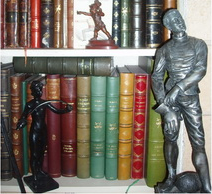
The end of the XIX th century seals the evolution of the trinity of weapons - epee, sabre and foil - but not necessarily their cohabitation. Between « art » and « sport », it will soon be necessary to choose. If fencing became a sport, it is partially thanks to epee. This weapon being by definition the weapon of duel, it had to be taught in schools and, with it, the realism begins to prevail over the romanticism.It is around 1890 that we begin to speak about fencing as a sport. Revolutionaries suggest to « judge» the bouts and count the hits of button.
Fencing, an art of enjoyment

The XIX th century was an extraordinary century - the golden age - for fencing, that nothing comes to oppose : the light and well-balanced weapons allow the execution of technical exploit safely, fencing masters, at the top of their science, sometimes of their genius, transmit and codify the art of « beautiful and fine foil ». They will be at the source of the tremendous influence of French and Italian fencing. The civil and military fencing schools multiply, the followers rush and develop a passion for this fashionable physical activity.
But fencing, also qualified as a mind game, will only become a sport at the end of this century. For the purists, it is just an enjoyment in which « the way of hitting is better than what we give ». Foil is king on the piste,sometimes even on the « ground » where the «sense of honour» (the duel), more democratised, is still very present.
International Fencing Federation
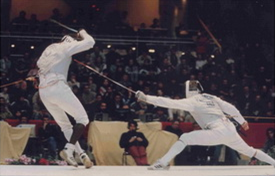
Further to the problems raised during the Olympic Games of 1908 (suppression of foil because of regulations) and of 1912 which led to the boycott of France at the Games of Stockholm, it is on René Lacroix's initiative, on 29 November 1913, in the lounges of the Automobile Club of France, that the FIE was created and that it adopted the 1st rules at epee (drafted by the marquis of Chasseloup-Laubat from France), at foil (drafted by the master Camille Prévost, from France as well), and at sabre (drafted by the Hungarian Bela Nagy).
The signalisation of hits
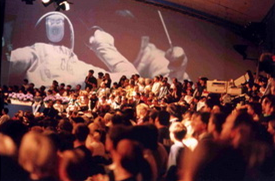
At the end of the XIX th century, we still rely on the « word of honour » of fencers to count the hits. Then appeared the famous push button, which were welded at the end of the epee and partially recovered with a sticky thread. The remaining point had to hang to the jacket of the opponent but without crossing it … what often happened. At the beginning of the 20s, the novelist Léon Sazie invented the push button at three branches, which was used for a long time in schools because it was practical and harmless.
Other inventions appeared to disappear immediately, following the example of stamping or detonating buttons. We imagined even to fence bare-chested, with the push button. This going back to the stop hit « to the first blood » gave concerns to more than one and worried the others. A big progress was then made by Paul Souzy with his « record player epee », composed of a box, a body wire and an epee. It signalised the hits with a battery-operated snorer and an electric light bulb, and marked in cochineal the place of the impact. We know the continuation : the electric apparatus of signalisation of hits was adopted by the federation in 1936. Historical achieved by Master Gérard Six